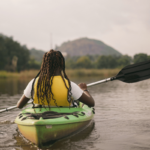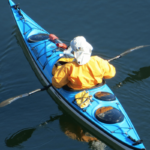Navigating the waters of nautical terminology can be as challenging as steering a canoe through a rapid river. The front end of a canoe, known by a specific term in English, carries a significant weight of history, design, and functionality. For both seasoned paddlers and curious newcomers, understanding this term not only enriches your boating lexicon but also deepens your appreciation for maritime culture. Join us as we explore the fascinating origins and importance of this essential canoe component.
Understanding the Bow of a Canoe
The front end of a canoe, known as the bow, is a critical component that plays a significant role in the vessel’s maneuverability, speed, and overall performance on the water. Unlike the stern (the rear end), the bow is designed to cut through the water with minimal resistance, allowing for smoother and faster travel. This part of the canoe often features a pointed or slightly rounded shape, which helps to efficiently divide the water as the canoe moves forward, reducing drag and enabling more effective navigation.
Moreover, the bow of the canoe is not just about physical attributes; it also holds importance in terms of handling and directional control. The person seated nearest to the bow, often referred to as the bow paddler, plays a crucial role in guiding the canoe, especially in challenging conditions such as rough waters or when dodging obstacles. The bow’s design, along with the skill of the bow paddler, can greatly influence the canoe’s ability to quickly and safely respond to steering commands, making it an essential aspect for both recreational and competitive canoeing.
Understanding the nuances of the bow’s design and functionality can enhance one’s canoeing experience. It allows paddlers to choose the right canoe for their needs, whether they are looking for speed, stability, or maneuverability. In addition, knowledge about the bow’s role in handling and control can inform better teamwork and coordination between the paddlers, leading to a more enjoyable and efficient journey across the water.
- Pointed or slightly rounded shape for efficient water cutting
- Crucial for maneuverability and speed
- Handled by the bow paddler for directional control
- Design influences the canoe’s response to steering commands
- Understanding the bow can enhance canoe selection and paddling teamwork
Exploring the Anatomy of a Canoe: The Bow
The front end of a canoe, known universally among paddling enthusiasts and experts alike as the bow, is more than just a pointy end designed to cut through water. Its design and structure are crucial for the canoe’s maneuverability, speed, and overall performance on the water. The bow’s shape can vary from one canoe model to another, reflecting the diverse purposes these boats serve, from tranquil lake paddling to navigating the rapids of a fast-flowing river.
Understanding the significance of the bow is essential for both novice and seasoned paddlers. It’s not just about aesthetics; the bow’s design impacts the canoe’s hydrodynamics. A well-designed bow will effortlessly slice through the water, reducing resistance and making paddling more efficient. This is particularly important in competitive canoeing, where every fraction of a second counts. Additionally, the bow is often equipped with additional features like handles or towing rings, enhancing its functionality and safety in various conditions.
Another aspect to consider is the bow’s role in buoyancy and stability. A canoe with a well-crafted bow will better handle waves and choppy water, keeping the paddlers dry and secure. Whether you’re embarking on a serene solo journey across a calm lake or tackling a challenging river with friends, knowing the intricacies of your canoe’s bow can significantly enhance your paddling experience.
| Feature | Impact on Performance | Consideration in Design |
|---|---|---|
| Shape | Reduces water resistance | Intended use of canoe (lake vs. river) |
| Size | Affects maneuverability | Canoe’s overall length and width |
| Additional Features | Enhances functionality and safety | Handles, towing rings |
| Material | Influences durability and weight | Composite, aluminum, or wood |
| Buoyancy | Improves stability in water | Design of the hull and bow’s volume |
Delving deeper into the nuances of canoe design reveals how integral the bow is not only to the canoe’s performance but also to the paddler’s experience. The bow’s construction and features can significantly influence how a canoe handles different water conditions. Whether it’s the streamlined shape for slicing through water with minimal effort, or the added buoyancy to tackle waves and maintain stability, the bow plays a pivotal role in ensuring an enjoyable and safe paddling adventure.
Anatomy of a Canoe Explained
The canoe, a vessel that has been used for centuries across various cultures and geographies, possesses a simple yet intricate design that has evolved to meet the demands of its users. At the core of its structure is the hull, which is the main body of the canoe. The shape of the hull plays a pivotal role in determining the canoe’s stability, speed, and maneuverability. A shallow hull allows for better speed and is ideal for calm waters, while a deep hull offers more stability in turbulent conditions.
At the front of the canoe, you’ll find the bow, a term that might seem shrouded in mystery for those new to canoeing. The bow is essentially the forward part of the canoe, designed to cut through the water efficiently, reducing resistance and making paddling easier for the canoeist. The rear end of the canoe is known as the stern, and it’s where you’ll often find the steering done, especially in models designed for solo paddling.
Another critical component is the gunwale (pronounced ‘gunnel’), which is the upper edge of the canoe’s sides. The gunwale adds strength to the structure and serves as a point of attachment for thwarts — crosspieces that span the width of the canoe to maintain its shape and distribute weight evenly. The yoke and seats are also integral to the canoe’s anatomy, providing comfort and functionality for the paddlers. The yoke is designed for portaging (carrying the canoe overland), and its placement is meticulously calculated to balance the canoe perfectly when lifted.
Further Insights into Canoe Design
Understanding the anatomy of a canoe extends beyond its physical components. The materials used in construction — from traditional wood and birch bark to modern composites like fiberglass and Kevlar — significantly affect the canoe’s weight, durability, and performance. Innovations in design and material have allowed for specialized canoes tailored to different activities, such as racing, fishing, and whitewater paddling, showcasing the versatility and enduring popularity of this ancient craft.
| Component | Function | Material Options |
|---|---|---|
| Hull | Main body, affects speed and stability | Wood, Fiberglass, Kevlar |
| Bow | Front part, cuts through water | Birch Bark, Composite Materials |
| Stern | Rear part, often used for steering | Aluminum, Wood Composites |
| Gunwale | Adds strength, attachment point for thwarts | Wood, Aluminum |
| Yoke | Used for portaging, balanced placement | Wood, Composite Materials |
Exploring the Evolution of Canoe Materials
In delving deeper into the evolution of canoe materials, one observes a fascinating transition from natural to synthetic. This shift not only reflects advancements in technology but also a change in the canoeist’s needs and preferences. Lightweight and durable materials like Kevlar and carbon fiber have made canoes more accessible and enjoyable for enthusiasts, without sacrificing the traditional aesthetic and functional characteristics that have defined the canoe for generations. This evolution underscores the canoe’s status as a versatile and enduring craft, adaptable to both the challenges of the wild and the requirements of modern recreation.
The Bow’s Role in Navigation
The front end of a canoe, known as the bow, plays a pivotal role in the vessel’s navigation and overall maneuverability. Its design, typically pointed and streamlined, allows the canoe to effortlessly cut through water, minimizing resistance and facilitating smoother travel. This aspect of the canoe is not just about aesthetics; it is fundamentally engineered to enhance performance in various aquatic environments. Whether navigating through calm lakes or negotiating the challenges of choppy river waters, the bow’s shape and functionality significantly influence the canoe’s handling and directional stability.
Moreover, the person seated nearest to the bow is often tasked with the critical role of a lookout, scanning for obstacles and navigating the safest and most efficient route. This positioning, coupled with the bow’s design, enables swift adjustments to the canoe’s trajectory, ensuring safer passage through potential hazards. The bow’s interaction with the water’s surface also plays a crucial role in determining the canoe’s speed. By slicing through the water efficiently, it reduces drag, allowing for greater speeds and less effort from the paddlers to maintain momentum. This efficiency is vital during long paddling sessions or when speed is of the essence.
Understanding the bow’s role in navigation is essential for both novice and experienced canoeists. It not only aids in mastering control over the canoe but also enriches the paddling experience by enabling a harmonious interaction with the water. The bow’s design and its strategic utilization are testament to the thoughtful engineering behind canoe construction, aimed at optimizing performance and safety on the water.
- Minimizes water resistance for smoother travel.
- Facilitates quicker and safer directional changes.
- Enhances the canoe’s speed by reducing drag.
- Improves maneuverability in diverse aquatic environments.
- Supports the lookout function for obstacle navigation.
Design Variations of Canoe Bows
The front end of a canoe, known as the bow, is not just a functional part designed to cut through water; it embodies the craftsmanship and purpose behind the canoe’s design. The variations in the design of canoe bows are influenced by a multitude of factors, including the type of waters they are intended for, the materials used in construction, and the cultural heritage of the canoe’s builders. Understanding these variations provides insight into the nuanced world of canoe design and its impact on performance, stability, and aesthetics.
One of the most notable differences in canoe bow designs is the degree of rocker, which refers to the curvature of the canoe’s bottom from bow to stern. Canoes designed for fast-moving rivers may have a pronounced rocker to navigate rapids more effectively, while those intended for calm waters might have a minimal rocker to enhance straight-line speed and efficiency. The shape of the bow, ranging from sharp and pointed to wide and rounded, directly affects how the canoe handles waves and water resistance. Sharper bows cut through water and waves more easily, offering speed and efficiency, while wider bows provide more stability and buoyancy, especially in rough water conditions.
Materials also play a crucial role in the design of canoe bows. Traditional wooden canoes often feature intricate designs with a steeply pointed bow, reflecting not only functional considerations but also the artistic expression of the canoe maker. Modern materials like fiberglass and Kevlar allow for more variety in bow shapes, including sleek, aerodynamic profiles that reduce drag and improve speed. The choice of material can also affect the weight and durability of the canoe, further influencing the preferred design based on the intended use and longevity of the canoe.
Impact of Bow Design on Canoe Performance
The design of a canoe’s bow significantly impacts its performance in water. The interplay between bow shape, rocker, and material choice determines how the canoe will handle different conditions. A well-designed bow can mean the difference between effortlessly gliding through calm lakes or skillfully maneuvering through challenging rapids. Canoe enthusiasts and builders alike dedicate significant effort to optimizing these design elements to suit specific activities, whether it be tranquil exploration, fishing, or whitewater adventures.
| Type of Canoe | Preferred Bow Shape | Material |
|---|---|---|
| River Canoe | Pointed with High Rocker | Fiberglass, Polyethylene |
| Lake Canoe | Wide with Minimal Rocker | Wood, Kevlar |
| Racing Canoe | Sleek and Pointed | Carbon Fiber, Kevlar |
| Fishing Canoe | Wide and Rounded | Polyethylene, Aluminum |
| Expedition Canoe | Pointed with Moderate Rocker | Fiberglass, Kevlar |
Exploring the Aesthetics of Canoe Bows
Beyond their functional implications, the design variations of canoe bows also have a significant aesthetic component. The bow is often the first part of the canoe to catch the eye, and its design speaks volumes about the craft’s character and heritage. From the sleek lines of modern racing canoes to the detailed carvings of traditional wooden canoes, the aesthetics of the bow contribute to the overall appeal and identity of the canoe. This blend of form and function embodies the artistry and engineering behind canoe construction, making each canoe unique in its own right.
Bow Features and Accessories
The front end of a canoe, known as the bow, is not only pivotal in dictating the vessel’s direction but also hosts a variety of features and accessories designed for performance, safety, and convenience. Understanding these components is essential for both novice and seasoned paddlers to enhance their canoeing experience.
One of the most notable features of the bow is its shape, which is often pointed and sleek to efficiently cut through water, reducing resistance and increasing speed. This design is complemented by several accessories that can be fitted or are already integrated into the bow. Among these, the bow deck plate is significant, providing structural integrity to the canoe and a platform for mounting additional gear. For those looking to navigate in low-light conditions, a bow light or reflectors can be crucial for visibility, ensuring safety during early morning or late evening paddles.
Storage is another key aspect of the bow’s design. Many canoes come with a built-in storage compartment or offer the option to add one. This space is ideal for keeping essential gear and personal items dry and secure. Additionally, for adventurers who like to capture their journeys, a camera mount can be attached to the bow deck plate, offering a stable and unobstructed point of view. Lastly, protective accessories like bow guards or bumpers are indispensable for minimizing wear and tear on the canoe, especially for those who frequently navigate rocky or shallow waters.
Understanding the role and potential of the bow’s features and accessories is fundamental in customizing your canoe for comfort, efficiency, and safety. Whether it’s adding a simple storage solution or enhancing visibility with lighting, these modifications can significantly improve your paddling experience.
| Accessory | Function | Benefit |
|---|---|---|
| Bow Deck Plate | Structural Integrity | Enhances durability and provides mounting space |
| Bow Light/Reflectors | Visibility | Improves safety in low-light conditions |
| Storage Compartment | Storage | Keeps gear dry and secure |
| Camera Mount | Documentation | Stable platform for capturing journeys |
| Bow Guard/Bumper | Protection | Minimizes wear and tear on the canoe |
In summary, the bow of a canoe is more than just the front end; it’s a hub of functionality and customization. By familiarizing yourself with its features and the accessories available, you can tailor your vessel to meet your specific needs and preferences. Whether it’s enhancing the canoe’s performance or ensuring your safety and comfort, these adjustments can make a significant difference in your paddling adventures. Remember, a well-equipped bow not only improves your experience on the water but also extends the longevity and utility of your canoe.
As we conclude this discussion, it’s clear that the bow’s importance extends beyond its role in steering and stability. It offers a realm of possibilities for customization and enhancement, making every canoeing experience unique and tailored to the individual. So, the next time you set out on the water, take a moment to consider how you can optimize your canoe’s bow for an even better journey.
I’m Adam Reynolds, a dedicated sports writer with a passion for both competitive gaming and betting. In my mid-thirties, I dive deep into the world of sports, providing insightful analyses and strategies to help readers make informed betting decisions. My experience spans various sporting events, where I blend my love for the game with a keen eye for betting trends. Whether I’m dissecting game tactics or offering betting tips, I aim to deliver content that is both engaging and practical. Join me as we explore the exciting intersection of sports and betting together.





